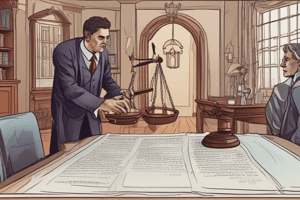Podcast
Questions and Answers
What must be the reasonableness of fear for coercion to be effective in inducing a contract?
What must be the reasonableness of fear for coercion to be effective in inducing a contract?
Threat must be sufficiently grave to affect the mind of a reasonably steadfast person.
In the case of Paragon Business Forms (Pty) Ltd v Du Preez, what was the court's opinion regarding the alleged fear of the former employee?
In the case of Paragon Business Forms (Pty) Ltd v Du Preez, what was the court's opinion regarding the alleged fear of the former employee?
The court found that the alleged fear of the respondent was illogical and unreasonable as there was no threat of dismissal expressed.
What objects must a threat be directed at for it to amount to duress?
What objects must a threat be directed at for it to amount to duress?
The threat must be directed at the life, bodily integrity, property, or immediate family.
Is silence generally indicative of free consent in cases of duress?
Is silence generally indicative of free consent in cases of duress?
Why does the threat need to be imminent or inevitable for it to be considered as duress?
Why does the threat need to be imminent or inevitable for it to be considered as duress?
What remedy attempts to restore both parties to the position they were in prior to entering into the contract?
What remedy attempts to restore both parties to the position they were in prior to entering into the contract?
When can the innocent party choose to rescind a contract?
When can the innocent party choose to rescind a contract?
What duty arises on both parties if a contract is rescinded?
What duty arises on both parties if a contract is rescinded?
Who has the onus to prove that undue influence occurred in a transaction?
Who has the onus to prove that undue influence occurred in a transaction?
What happens if the innocent party chooses to uphold the contract?
What happens if the innocent party chooses to uphold the contract?
What happens to the contract if the innocent party elects to rescind it?
What happens to the contract if the innocent party elects to rescind it?
What is the aim of the restitutio in integrum remedy?
What is the aim of the restitutio in integrum remedy?
What are the requirements for a misrepresentation to be considered valid?
What are the requirements for a misrepresentation to be considered valid?
What is active concealment in the context of misrepresentation?
What is active concealment in the context of misrepresentation?
What is designed concealment (non-disclosure) in the context of misrepresentation?
What is designed concealment (non-disclosure) in the context of misrepresentation?
What was the outcome of the case Dibley v Furter 1951 (4) SA 73 (C)?
What was the outcome of the case Dibley v Furter 1951 (4) SA 73 (C)?
Explain the impact of intentional concealment in the case of Dibley v Furter 1951 (4) SA 73 (C).
Explain the impact of intentional concealment in the case of Dibley v Furter 1951 (4) SA 73 (C).
How can misrepresentation occur through active concealment?
How can misrepresentation occur through active concealment?
What distinguishes designed concealment (non-disclosure) from other forms of misrepresentation?
What distinguishes designed concealment (non-disclosure) from other forms of misrepresentation?
What are the circumstances under which disclosure is obligatory?
What are the circumstances under which disclosure is obligatory?
What is the distinction between misrepresentation and other pre-contractual misstatements?
What is the distinction between misrepresentation and other pre-contractual misstatements?
What are the remedies available in cases of misrepresentation?
What are the remedies available in cases of misrepresentation?
When is non-disclosure of a fact considered actionable?
When is non-disclosure of a fact considered actionable?
What is the significance of duty in the context of non-disclosure?
What is the significance of duty in the context of non-disclosure?
How does misrepresentation by silence differ from other forms of misrepresentation?
How does misrepresentation by silence differ from other forms of misrepresentation?
Why is full disclosure particularly important in insurance contracts regarding risk?
Why is full disclosure particularly important in insurance contracts regarding risk?
Define causal misrepresentation.
Define causal misrepresentation.
What is the difference between causal misrepresentation and incidental misrepresentation?
What is the difference between causal misrepresentation and incidental misrepresentation?
Explain the types of misrepresentation mentioned in the text.
Explain the types of misrepresentation mentioned in the text.
What is the key requirement for misrepresentation to induce a contract?
What is the key requirement for misrepresentation to induce a contract?
In the context of misrepresentation, when can a party obtain rescission and restitution?
In the context of misrepresentation, when can a party obtain rescission and restitution?
What is the significance of intention in misrepresentation cases?
What is the significance of intention in misrepresentation cases?
Under what condition would there be no rescission even in the presence of misrepresentation?
Under what condition would there be no rescission even in the presence of misrepresentation?
Provide an example of incidental misrepresentation.
Provide an example of incidental misrepresentation.
Reference a case that highlights the importance of misrepresentation inducing the contract.
Reference a case that highlights the importance of misrepresentation inducing the contract.
Flashcards are hidden until you start studying
Study Notes
Disclosure and Misrepresentation
- Disclosure is obligatory in certain circumstances, such as when an omission of facts creates a misleading impression, or when a person makes a statement that is no longer correct due to a change in circumstances.
- Full disclosure is required in contracts, such as insurance contracts, to inform the other party of risks involved.
Misrepresentation
- Misrepresentation is a false statement of fact(s) made by one party to another before or at the time of the contract concerning some matter or circumstance relating to it.
- Requirements for misrepresentation:
- Must be a false statement of fact(s).
- Must be material.
- Made by a contracting party or someone for whom they assume responsibility.
- Made with the intention of persuading the other party to conclude the contract.
- Must be made in such a way that the other party believes the facts to be as represented and concludes the contract on the basis of the misrepresented facts.
Types of Misrepresentation
- Express statement, verbal statement, or implied from conduct.
- Active concealment: failure to correct a false impression.
- Designed concealment (non-disclosure): intentional concealment of information that the person is under a duty to disclose.
Cases
- Dibley v Furter 1951 (4) SA 73 (C): failure to disclose the existence of a graveyard on a farm.
- Paragon Business Forms (Pty) Ltd v Du Preez 1994 (1) SA 434 (SE): no threat of dismissal was found to be unreasonable.
Duress
- Coercion operates on the mind of the victim by forcing them to choose between entering the contract or suffering harm.
- Requirements for duress:
- Reasonableness of fear: the threat must be sufficiently grave to affect the mind of a reasonably steadfast person.
- Object of the threat: the threat must be directed at the life, bodily integrity, or property, or immediate family.
- Imminence of harm: the threat must be imminent or inevitable.
Undue Influence
- Undue influence occurs when one person exploits their influence over another to persuade them to agree to a transaction that is detrimental to them.
- Remedy for undue influence: restitutio in integrum (action and defense).
- Restitutio in integrum attempts to restore both parties to the position they were in prior to entering into the contract.
- The innocent party has the option to uphold or rescind the contract, and if they choose to rescind, the contract terminates upon receipt of notice.
- A duty then arises on both parties to restore and/or return any performance made in terms of the contract.
Types of Misrepresentation
- Intentional (fraudulent) misrepresentation.
- Negligent misrepresentation.
- Innocent misrepresentation.
Studying That Suits You
Use AI to generate personalized quizzes and flashcards to suit your learning preferences.




